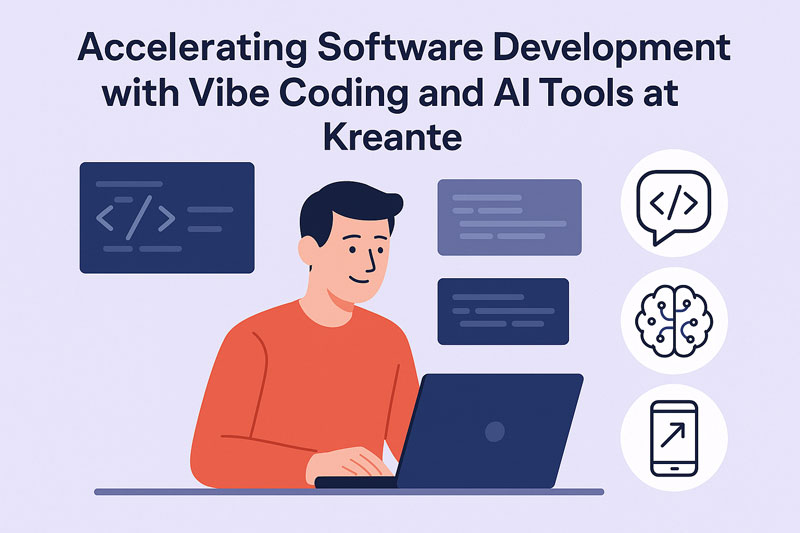

Introduction to NoCode Development: Benefits, Platforms, and Key Differences
Published on December 26, 2024
By Evelyn Castro · 8 minute read
What is NoCode?
NoCode is a revolutionary software development approach that empowers users to create applications without the need for traditional coding. By leveraging visual tools and pre-built components, NoCode platforms abstract the complexities of coding, making app development accessible to individuals without extensive coding knowledge. Users can simply drag and drop elements within a visual interface to build functional applications quickly and efficiently. This democratization of app development allows business users, marketers, and other non-technical professionals to bring their ideas to life without relying on professional developers.

Some Examples of NoCode Platforms
The NoCode landscape is rich with platforms that cater to various development needs. Here are some popular NoCode platforms:
Bubble: Known for its robust capabilities in web and mobile application creation, Bubble offers numerous tools and preconfigured modules, including version management and payment processing.
Webflow: This platform is more precisely intended for web designers thanks to its precise and powerful graphic editor. Once the development of the site is done, it can be published and hosted on the platform or exported to another host. Webflow also has components dedicated to the creation of forms or animations.
Adalo: This platform focuses on building mobile applications with ease, offering a range of templates and components.
Glide: Glide allows users to create mobile apps from Google Sheets, making it incredibly user-friendly and accessible.
These NoCode platforms offer a range of features, including visual interfaces, drag-and-drop functionality, and pre-built components, enabling users to build applications without writing a single line of code.
As a NoCode and Low Code agency, we offer our services for all your digital development projects. A tailor-made service, in accordance with your recommendations. A dedicated team is at your disposal from the creation to the follow-up of your application to face any problem of use.
How NoCode Works
NoCode platforms operate by providing a visual interface that simplifies the app development process. Users can drag and drop components, configure settings, and connect data sources to create a fully functional application. These platforms utilize a combination of model-driven development, automatic code generation, and visual programming to abstract the complexities of traditional coding. This approach allows users to focus on the design and functionality of their applications without needing to understand the underlying code. The result is a rapid application development process that is both efficient and accessible to different professionals.
What are the Differences Between NoCode and LowCode?
While NoCode and LowCode are often mentioned together, they cater to different user bases and have distinct characteristics. NoCode platforms are designed for users with no coding skills, providing a completely visual and intuitive development experience. In contrast, LowCode platforms require some coding knowledge and are often used by professional developers to accelerate the development process. LowCode platforms offer a more visual approach to development but still involve writing some code, making them suitable for more complex applications. NoCode platforms, on the other hand, are geared towards non-technical users who want to build applications without any coding. Both approaches aim to streamline app development, but they serve different purposes and audiences.

Other differences between No Code and Low Code
The Low Code development method is halfway between the classic development method and NoCode. The importance of selecting the right tool cannot be overstated, as it involves evaluating various criteria such data integration, collaboration between team members and application lifecycle management.
In practice, the tools of Low Code and NoCode complement each other. Some specialists even classify NoCode platforms as specialized Low Code tools. Low code development platforms are crucial in application design and development, accommodating users with varying coding skills. The distinction between Low Code and No Code methodologies is highlighted by the fact that Low Code Development Platforms (LCDPs) require some level of coding knowledge. However, they still enable business users to efficiently create applications by providing a more visual development approach.
Many people often confuse these two concepts, but they are distinct methods with different purposes.
Concretely, Low Code is aimed at developers with a basic knowledge of coding. The objective is to improve their productivity, via the performance of the tools used. NoCode is intended for people who want to develop applications, without having any particular skills in this field.
The first elementary steps of the project can be undertaken by a normal member of the company. However, it is essential to ask for the services of a developer when it comes to finalizing the creation.
What are the advantages of opting for NoCode without coding skills?
The programming market is facing a lack of physical resources, that is to say, experts, in the field of digital development. NoCode is therefore an interesting alternative to accompany companies in their digital transformation. Here is an overview of the main advantages of this method.
Limitations of NoCode
Despite the numerous advantages of NoCode platforms, there are some limitations to consider:
Limited Customization Options: NoCode platforms often have predefined templates and components, which can restrict the level of customization available. This can be a challenge when building complex applications that require unique features.
Scalability Considerations: While NoCode platforms have traditionally faced challenges in scaling, recent advancements have improved their capacity to handle larger applications. However, it's important to evaluate whether the platform can meet the specific scalability needs of your project, especially if you anticipate significant growth or complex requirements.
Limited Integration: Integrating NoCode applications with existing applications or systems can be challenging. NoCode platforms may not offer seamless integration capabilities, which can hinder the overall functionality of the application.
These limitations highlight the importance of carefully evaluating the needs and requirements of your project before choosing a NoCode platform.
The Role of AI in NoCode
Artificial intelligence (AI) is playing an increasingly significant role in enhancing NoCode platforms. Here are some ways AI is being integrated:
Predictive Analytics: AI-powered predictive analytics can help users make data-driven decisions, improving the effectiveness of their applications.
Machine Learning: AI-powered machine learning enables applications to learn and adapt to user behavior, providing a more personalized user experience.
Natural Language Processing: AI-powered natural language processing allows applications to understand and respond to user input, making them more interactive and user-friendly.
Overall, AI integration in NoCode platforms enhances their capabilities, making them more powerful and versatile. This combination of NoCode and AI enables rapid application development, allowing users to build sophisticated applications with ease.
By understanding the benefits and limitations of NoCode platforms, users can make informed decisions and leverage these tools to their fullest potential.

A great flexibility in terms of use
NoCode is appreciated for its flexibility. In concrete terms, a company’s marketing department can directly launch and test a product to deal with a new constraint. NoCode development approaches are designed to enable line-of-business users who lack programming skills to create software applications easily. For example, there is no need to go to the IT department to create an application to manage a marketing project.
Significant financial savings
While some NoCode platforms like Softr offer free plans, the overall cost of accessing premium features is still significantly lower compared to hiring a team of developers. This is a real asset for start-ups that do not have a sufficient budget at their disposal. NoCode platforms usually offer affordable rates, including low-cost packages for initial testing.
A way to optimize productivity
Thanks to their ergonomics and intuitiveness, NoCode tools can greatly improve the productivity of both experienced and non-experienced developers.
In the case of in-house programming, these tools complement the company's IT resources. You can benefit from rapid development.
Conclusion
NoCode development platforms have revolutionized the way applications are built, offering a user-friendly and efficient alternative to traditional coding. By empowering non-technical users to create web and mobile applications through intuitive drag-and-drop interfaces, these platforms have democratized app development and opened new opportunities for innovation.While NoCode platforms provide significant advantages, such as reduced costs and increased flexibility, they have traditionally faced challenges in customization and scalability. However, advancements in NoCode tools have led to the development of platforms that are now scalable, effectively addressing these concerns and expanding the potential for more complex applications.However, with the integration of AI technologies, NoCode platforms are becoming increasingly powerful, allowing users to develop more sophisticated applications. As businesses continue to embrace digital transformation, NoCode platforms will play a crucial role in enabling rapid application development and meeting diverse business needs. By carefully evaluating the capabilities and limitations of NoCode tools, organizations can effectively leverage them to drive growth and innovation.

Accelerating Software Development with Vibe Coding and AI Tools at Kreante

Kreante: Accelerating Your AppDevelopment with Low-Code, AI, and “Vibecoding”




.png)


.svg)
